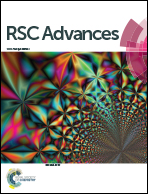Quantitative analysis of the structural stability and degradation ability of hydroxyapatite and zirconia composites synthesized in situ
Abstract
In situ synthesis has been attempted in the present study to form hydroxyapatite [HAP, Ca10(PO4)6(OH)2] and zirconia [ZrO2] composite powders. The synthesis has been attempted using an aqueous precipitation technique in which alterations have been made to the starting Ca/P molar ratio of calcium phosphate suspensions together with five different concentrations of ZrO2 precursors. An additive in the form of yttria to stabilize tetragonal ZrO2 (t-ZrO2) has not been used in the present investigation. The precipitated powders resulting were heat treated at different temperatures before determination of the phase stability and degradation ability of the HAP–ZrO2 composites. The powders were characterized by X-ray diffraction, Raman spectroscopy and quantitative analysis by Rietveld refinement. The results from the investigation confirmed the formation of HAP–ZrO2 composites at 900 °C. The Ca/P precursors with molar ratios of 1.67 and 1.69 have yielded the formation of β-tricalcium phosphate [β-TCP, β-Ca3(PO4)2] with a content of less than 5 wt% together with HAP and t-ZrO2 at 900 °C. The Ca/P precursors with a molar ratio of 1.68 have yielded only HAP and t-ZrO2 composite powders at 900 °C. The increased addition of ZrO2 precursors had resulted in the enhanced formation of t-ZrO2 with a simultaneous reduction in the amount of the HAP phase formed. However, heat treatment at 1000 °C and 1100 °C has initiated the degradation of HAP and t-ZrO2 composite powders resulting in the formation of monoclinic ZrO2 (m-ZrO2). It is surmised from the present results that there is active involvement of the ZrO2 content in the degradation behaviour of the HAP–ZrO2 composite powders.


 Please wait while we load your content...
Please wait while we load your content...